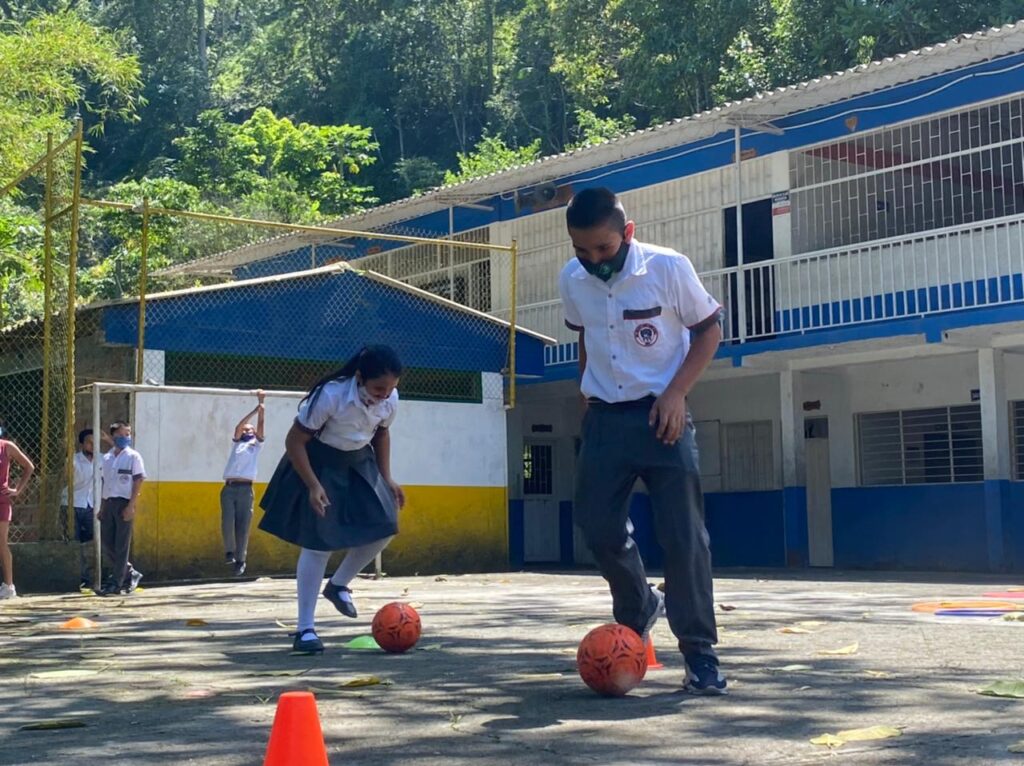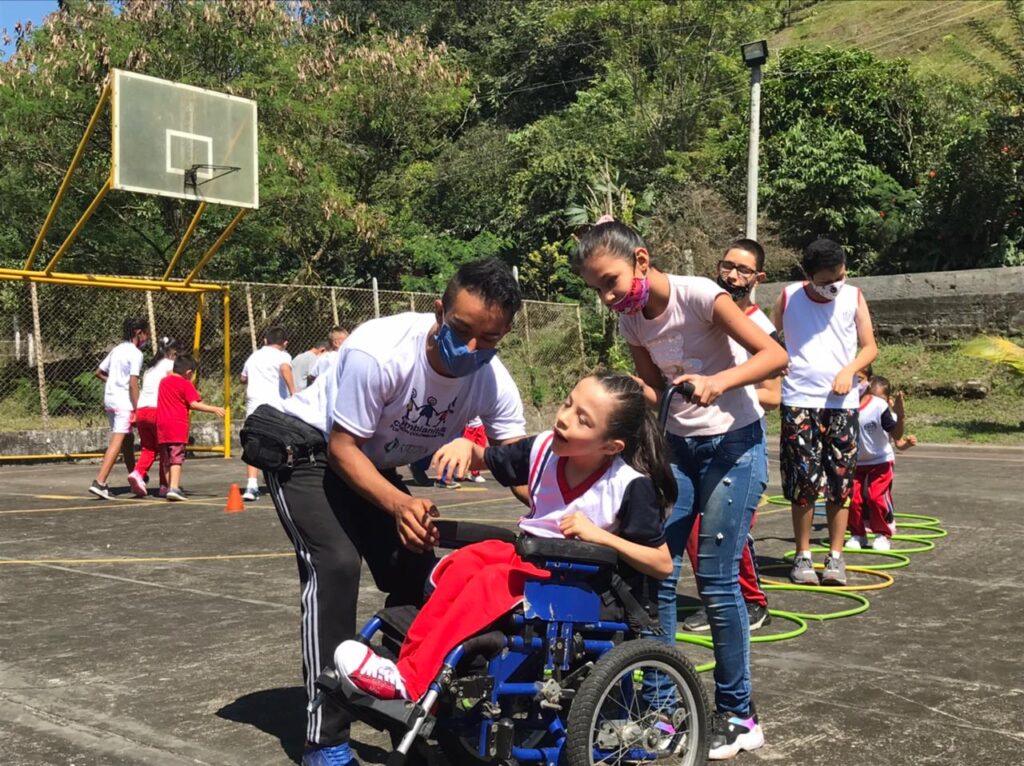Dropping out of school is one of the biggest problems that boy, girls and young adults face in rural areas of the country, such as Muzo, a municipality that is located in the western part of the Boyacá department, known as the " World capital of emeralds" 33% of the students leave their studies due to different factors: economical issues, frequent familial moving or violence.
In the company of the Muzo Foundation and the Bolívar Davidienda foundation, we initiated the project: 'Un gol a la deserción' (A goal to desertion). It aims to benefit 220 people including boys, girls, parents and teachers in the Muzo municipality.
This initiative implements educational, athletic and psychosocial strategies in the educational institution ‘Concha Medina de Silva’ and its six centers: La Isla, La Cañada, Sabripa, Guadualon, la Paita y Cristales, promoting education continuation and inclusion as a environmental protector.
" In the educational institution, formative actions, active methods and strategies are executed in order to promote scholar permanency and inclusion, while the beneficiaries of the project strengthen their social emotional skills to prevent perilous factors in their essential development", says. Gladys Sanmiguel, Executive Director at the Colombianitos Foundation.

The target population is made up of boys and girls currently enrolled in school, ranging from 1-12th grade and between the ages of 6 and 18 . This project also has 16 teaches of the educational institution, who participate on skill and method transfer days.
The project consists of the adaption of athletic training grounds to the inclusive necessities of the boys and girls of the area, the adaption of the methodology implemented by Colombianitos allows for an inclusive focus with children with disabilities like autism, Aspergers, Down Syndrome, Tourettes, Cognitive deficit disorder, cerebral palsy, blindness and deafness.
Also, there are psychosocial training spaces for parents and/or caregivers of the beneficiaries, to effectively involve them in the academic processes of their children.
This type of initiative at the territories are strategies that allow communication spaces be created in favor of the boys, girls and young adults, helping them strengthen lifetime abilities, promote social emotional and academic skills, redefining their life plan as a way to promote the continuing and completion of their studies and even more so when their teachers and parents and/or guardians are involved.
Providing for these territories, how have historically the victims of violence, exploitation, prostitution and the violation of other rights, is of great relevance, because it allows for connections to be made with the main educators of the territory that are often forgotten by the boys, girls and young adults of the region.
The Colombianitos Foundation has developed educational processes with the educational institution in a joint effort with the mining foundation MTC; a situation that favor the reception of the community and allows for the opportunity to continue the process that started in 2017.
Figures and precursors of educational dropouts in Boyacá
Scholar abandonnement is a phenomenon that every educational institution needs to face head on, in the department of Boyacá the reports that are registered in the SIMAT, corresponds in greatly to student transfers due to their parents moving away to a different department, affecting significantly the coverage of the department. This is reaffirmed by the ENDE (2019) that claims 33% of the students drop out due to forced relocation.
According to the informant ‘Crecer con hechos y derechos. Primera infancia, infancia, adolescencia y Juventud’ (Boyacá, 2019), dropping out in Boyacá happens in the following manner:
"The elementary school drop out rates showed an increase between the years 2015-2016. For 2015, the dropout rate was at 2.54% which equates to 1,442 students dropping out of school; the greatest dropout rate was in 2016 with 1,489 students, most of which from the urban area where the greatest amount of students are enrolled, many were actually from rural areas but were forced to relocate to urban areas to continue attending school. For the years 2017 and 2018, this relationship diminished from 2.53% to 2.07%.

The average level that corresponds to the tenth, eleventh, twelfth and thirteenth grade, the rate of school dropouts for 2015 increased to 1.96% which is equivalent to a total of 416 students enrolled at this municipality level that are not certified by the department of Boyacá, 228 of the dropouts are a part of the urban zone and the rest are part of the rural zone".
The desertion levels of basic and middle education in the Boyacá department is a worrying situation now that 13% of individuals over fifteen year of age are illiterate (DANE IPM,2018). This reality, worsens the inequality between the rural inhabitants. According to the calculations done by the done by the Ministry of Education, the estimation of the dropout rates from the previous year was of 2.99%. (April 2021)
Situation in Muzo
This desertion situation has added to it cultural and social characteristics that the municipality of Muzo has due to it being the emerald region causing: hierarchical power, appropriation of territory. The presence of legal companies like MTC has generated a legislation culture, stable labor and support for the need of the communities that live near the mines.
Sin embargo, aún se encuentran las familias de los guaqueros, familias campesinas tradicionales y se sigue presentado fenómenos de explotación y comercialización de esmeralda.
Los pobladores de Muzo hablan de un pasado de mucha violencia con un gran ‘derramamiento de sangre’ a los cuales se les sumaban los vicios del alcohol o la prostitución, pero, actualmente, ya no se presentan de manera evidente dichas situaciones, sino que hay una pobreza extrema en especial en las cercanías a los sectores mineros. Anteriormente, cuentan los habitantes de Muzo, cuando no existía la empresa, la gente podía buscar la esmeralda de manera más libre lo cual implicaba un derroche del dinero producido por la fácil comercialización.
Este panorama impacta a los NNAJ que están incluidos de manera directa e indirecta, en las poblaciones juveniles se generan problemas de exclusión, falta de oportunidades, reproducción de la pobreza, embarazos a temprana edad, altos índices de muerte violenta, marginalización del acceso a la ciencia y la tecnología, a la participación en ámbitos políticos, a la recreación entre otros.
Estas dificultades se convierten en factores para que los jóvenes empieces a dejar al lado el interés por sus estudios e ingresen a diversos entornos de ilegalidad como redes de narcotráfico y contrabando, prostitución y a grupos armados al margen de la ley como guerrillas, paramilitares, delincuencia común, milicias privadas.
Según el DANE y sus Proyecciones de población para el 2019, el 24,14% de la población en Muzo está entre los 15 y 29 años, es decir, aproximadamente dos mil jóvenes pertenecen a la población muceña para el año 2019.
La experiencia que ha tenido la Fundación en el territorio de Muzo y el acercamiento con los estudiantes, docentes, familias y la institución ratifica la necesidad de continuar implementando estrategias que aborden temas relacionados con las habilidades para la vida, competencias lectoras y de matemáticas, proyecto de vida, metodologías activas en los docentes, así como, incluir a sus familias como sistema esencial para el crecimiento integral de los NNAJ.






